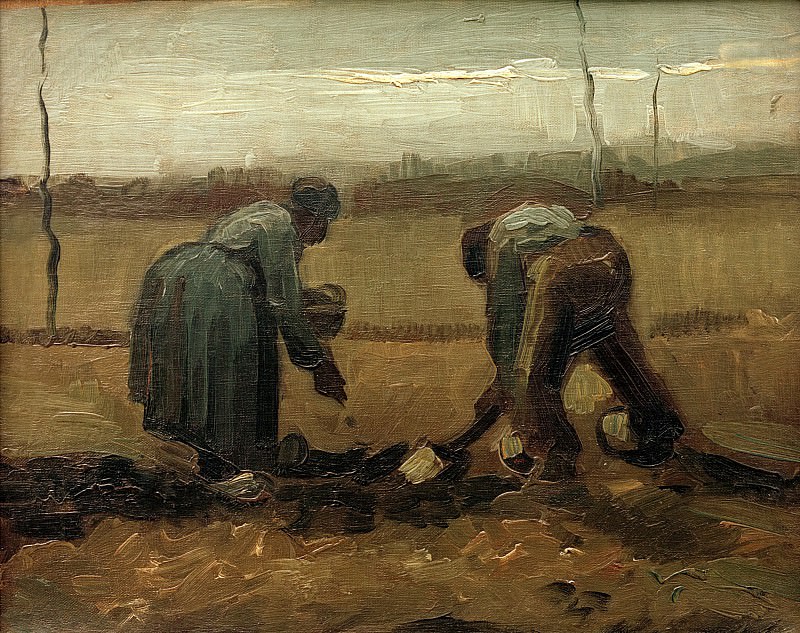Peasants Planting Potatoes Vincent van Gogh (1853-1890)
Vincent van Gogh – Peasants Planting Potatoes
Edit attribution
Download full size: 3118×2466 px (2,3 Mb)
Painter: Vincent van Gogh
Location: Kunsthaus, Zürich.
The painting is attributed to one of Van Gogh’s early works. The painting, describing the labor of peasants, was created by the master in 1885. During this period the artist struggled with himself: he longed to master the classical techniques and techniques of painting, but the lack of education became an obstacle on the way. These failures painfully reflected in the creative soul of a genius. Van Gogh’s greatest difficulty was giving the human figure.
Description of Vincent van Gogh’s painting "Peasant and Peasant Woman Planting Potatoes"
The painting is attributed to one of Van Gogh’s early works. The painting, describing the labor of peasants, was created by the master in 1885. During this period the artist struggled with himself: he longed to master the classical techniques and techniques of painting, but the lack of education became an obstacle on the way. These failures painfully reflected in the creative soul of a genius. Van Gogh’s greatest difficulty was giving the human figure. The inability to portray the man on the canvas caused irritation and despair.
Difficulties with the image of a person made itself felt the static nature of the images, the awkwardness of their movements. But at the same time the figures, which were deprived of dynamics, became a part of the unspiritual nature around them, merging with the earth.
These features of the human figure were reflected in the image of a peasant and a peasant woman engaged in work. The artist depicts them in the form of two rocks. They are striking in their power and strong connection with the soil on which they stand. This effect is only strengthened by the high line of the horizon, which was made by the artist intentionally. But the connection to the land is the essence of peasant life: without land, the peasant does not exist - then he is nothing.
Even the shadows, long and dark, act as the fetters by which the peasants are bound to the land. The low horizon line only tilts the figures even further, reducing the distance to the ground. The bent postures symbolize not the peasants’ low position in society, but their respect for their breadwinner the earth.
Created in a spirit of realism, the canvas does not lose its integrity and profound meaning through the slight awkwardness of the people depicted or the inaccuracy of their proportions. The composition, as well as the color scheme, are in harmony, confirming the correctness of the color scheme.
The entire painting speaks of the artist’s deep respect for the peasants and their labor. The monumental figures that stand so firmly on the ground will not allow humanity and humanity to be lost.
Кому понравилось
Пожалуйста, подождите
На эту операцию может потребоваться несколько секунд.
Информация появится в новом окне,
если открытие новых окон не запрещено в настройках вашего браузера.
You need to login
Для работы с коллекциями – пожалуйста, войдите в аккаунт (open in new window).




















You cannot comment Why?
The subtext of this painting lies in its portrayal of agricultural work and the dignity of peasant life. Van Gogh was deeply interested in depicting the lives of ordinary working people, often imbuing them with a sense of resilience and nobility. The act of planting potatoes is a fundamental act of sustenance, connecting the figures directly to the earth and the cycle of life. The somber palette and the physical exertion of the figures emphasize the demanding nature of their labor, but also their connection to the land and their vital role in providing for themselves and others. The painting can be seen as a tribute to the strength and perseverance of those who toil in the fields, highlighting the beauty and importance of their everyday existence.